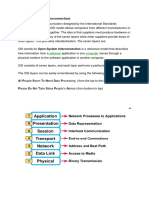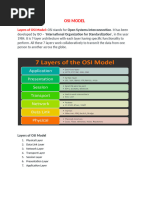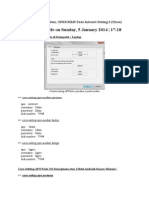OSI model
Uploaded by
iamrishabhdwivedi12OSI model
Uploaded by
iamrishabhdwivedi12Application layer (Layer 7) :
1. This layer also serves as a window for the application services to access
the network and for displaying the received information to the user.
Ex: Application – Browsers, Skype Messenger, etc.
2.These applications produce the data, which has to be transferred over the
network.
**Application Layer is also called Desktop Layer.
3.A few examples of application layer protocols are the Hypertext Transfer
Protocol (HTTP), File Transfer Protocol (FTP), Post Office Protocol (POP),
Simple Mail Transfer Protocol (SMTP), and Domain Name System (DNS).
Presentation Layer (Layer 6) :
1.The presentation layer is also called the Translation layer. The data from the
application layer is extracted here and manipulated as per the required format to
transmit over the network.
The functions of the presentation layer are :
Translation: For example, ASCII to EBCDIC.
Encryption/ Decryption: Data encryption translates the data into another form
or code. The encrypted data is known as the ciphertext and the decrypted data is
known as plain text. A key value is used for encrypting as well as decrypting data.
Compression: Reduces the number of bits that need to be transmitted on the
network.
The presentation layer prepares data for the application layer. It
defines how two devices should encode, encrypt, and compress data
so it is received correctly on the other end. The presentation layer
takes any data transmitted by the application layer and prepares it
for transmission over the session layer.
Session Layer (Layer 5) :
1.This layer is responsible for the establishment of connection, maintenance of
sessions, authentication, and also ensures security.
The functions of the session layer are :
2.Session establishment, maintenance, and termination: The layer allows the two
processes to establish, use and terminate a connection.
3Synchronization: This layer allows a process to add checkpoints which are
considered synchronization points into the data. These synchronization points help
to identify the error so that the data is re-synchronized properly, and ends of the
messages are not cut prematurely and data loss is avoided.
Dialog Controller: The session layer allows two systems to start communication with
each other in half-duplex or full-duplex.
The session layer creates communication channels, called sessions,
between devices. It is responsible for opening sessions, ensuring
they remain open and functional while data is being transferred,
and closing them when communication ends. The session layer can
also set checkpoints during a data transfer—if the session is
interrupted, devices can resume data transfer from the last
checkpoint.
Transport Layer
The transport layer takes data transferred in the session layer and
breaks it into “segments” on the transmitting end. It is responsible
for reassembling the segments on the receiving end,
Network Layer
The network layer has two main functions. One is breaking up
segments into network packets, and reassembling the packets on
the receiving end. The other is routing packets by discovering the
best path across a physical network. The network layer uses
network addresses (typically Internet Protocol addresses) to route
packets to a destination node.
Data Link Layer
The data link layer establishes and terminates a connection between
two physically-connected nodes on a network. It breaks up packets
into frames and sends them from source to destination. This layer is
composed of two parts—Logical Link Control (LLC), which identifies
network protocols, performs error checking and synchronizes
frames, and Media Access Control (MAC) which uses MAC addresses
to connect devices and define permissions to transmit and receive
data.
The physical layer is responsible for the physical cable or wireless
connection between network nodes. It defines the connector, the
electrical cable or wireless technology connecting the devices, and
is responsible for transmission of the raw data, which is simply a
series of 0s and 1s, while taking care of bit rate control.
* Hub, Repeater, Modem, Cables are Physical Layer devices.
TOPOLOGY
Network topology refers to the manner in which the links and nodes of a network are
arranged to relate to each other. ... Physical network topology examples include star, mesh,
tree, ring, point-to-point, circular, hybrid, and bus topology networks, each consisting of different
configurations of nodes and links.
Ring bus mesh star
You might also like
- Data communication and networking notesNo ratings yetData communication and networking notes13 pages
- DCC Chapter 5 Notes - Ur Engineering Friend (2nd)No ratings yetDCC Chapter 5 Notes - Ur Engineering Friend (2nd)16 pages
- Layers of OSI Model: Basics of Computer NetworkingNo ratings yetLayers of OSI Model: Basics of Computer Networking7 pages
- # TCP/IP Protocol Layers:-1.application Layer: Protocols UsedNo ratings yet# TCP/IP Protocol Layers:-1.application Layer: Protocols Used8 pages
- Introduction to Computer Network & InternetNo ratings yetIntroduction to Computer Network & Internet3 pages
- Ip Address and Subnetting: Module Page 1/6 Document Page 1No ratings yetIp Address and Subnetting: Module Page 1/6 Document Page 17 pages
- VxRail Appliance - VxRail Customer Installation Procedures-VxRail E660 - E660FNo ratings yetVxRail Appliance - VxRail Customer Installation Procedures-VxRail E660 - E660F59 pages
- Course Outline CSCD 607 Advanced Computer NetworksNo ratings yetCourse Outline CSCD 607 Advanced Computer Networks9 pages
- Mc5303-Web-Programming-Essentials-All UnitsNo ratings yetMc5303-Web-Programming-Essentials-All Units75 pages
- Advanced Computer Networks Week-3 AssignmentNo ratings yetAdvanced Computer Networks Week-3 Assignment4 pages
- SPARSH-M2S-configuration-for-Apple-DevicesNo ratings yetSPARSH-M2S-configuration-for-Apple-Devices14 pages
























































































